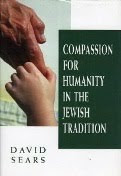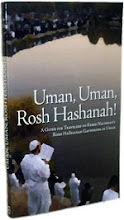(Painting by Larry Poons)
In honor of the upcoming yahrtzeit of the Maggid of Mezeritch,
“Yud-Tes Kislev,” we are posting several translations from the Maggid’s
teachings on “Nothingness (Ayin)” from Rabbi Aryeh Kaplan’s “Meditationand Kabbalah” (Samuel Weiser), pp. 300-303.
As Rabbi Kaplan later shows in his ground-breaking book, this
mystical theme is picked up by the Maggid’s illustrious disciple, Rabbi Levi
Yitzchak of Berditchev in “Kedushas Levi.” It is also central to the
thought of another towering disciple of the Maggid, Rabbi Menachem Mendel of
Vitebsk, in “Pri Ha’aretz.” In recent years, these concepts have served
as the foundation for a revival of Chassidic meditation in Jerusalem.
Nothingness (Ayin)
The many levels of the mind include the thinker, thought and
speech. One is influenced by the other.
Speech exists in time. Thought is also in time, since a person
has different thoughts at different times.
There is also an essence that binds the thinker to thought.
This is an essence that cannot be grasped. It is the attribute of Nothingness.
It is often referred to as the Hyle [the state between potential and
realization].
An egg becomes a chicken. There is, however, an instant when
it is neither chicken nor egg. No person can determine that instant, for in
that instant, it is a state of Nothingness.
The same is true of the transition of thinker to thought, or
of thought to speech. It is impossible to grasp the essence that unites them … In
order to bind them all together, one must reach the level of Nothingness.
Moses thus said, “If Nothingness, erase me” (Exodus 32:32).
[The Israelites had bowed down to the Golden Calf and] had been blemished by
idolatry. What Moses wanted to do was elevate them back to their original
level. He therefore brought himself to the level of Nothingness, and [wishing
to go still higher he prayed, “erase me” [Rabbi Kaplan here references the
Abulafian technique of “erasing (mechikah)” all mental images from the
mind.] When [Moses] reached the highest level, he was able to bind all things
on high (Maggid Devarav le-Yaakov #96).
***
Think of yourself as nothing, and
totally forget yourself when you pray. Only have in mind that you are praying
for the Divine Presence.
You can then enter the Universe of Thought, a state that is
beyond time. Everything in this realm is the same, life and death, land and
sea.
... But in order to enter the Universe of Thought, where all
is the same, you must relinquish your ego, and forget all your troubles.
You cannot reach this level if you attach yourself to physical
worldly things. For then, you are attached to the division between good and
evil, which is included in the seven days of creation. How then can you
approach a level above time, where absolute unity reigns?
Furthermore, if you consider yourself as “something,” and ask
for your own needs, then God cannot clothe Himself in you. God is infinite, and
no vessel can hold Him at all, except when a person makes himself like Nothing
(Maggid Devarav le-Yaakov #159).
***
In prayer, you must place all your strength in the words,
going from letter to letter until you totally forget your body. Thinking how
the letters permute and combine with each other, you will have great delight.
If this is a great physical delight, it is certainly a great spiritual delight.
This is the Universe of Yetzirah, [the world of Speech].
The letters then enter your thoughts, and you do not even hear
the words that you pronounce. This is the Universe of Beriyah, [the world of
Thought].
You then come to the level of Nothingness, where all your
[senses and] physical faculties are nullified. This is the Universe of Atzilut,
[which parallels] the Attribute of Chokhmah‑Wisdom (Maggid Devarav le-Yaakov
#97).
***
Nothing can change from one thing to another [without first
losing its original identity]. Thus, for example, before an egg can grow into a
chicken, it must first cease totally to be an egg. Each thing must lose its
original identity before it can be something else.
Therefore, before a thing is transformed into something else,
it must come to the level of Nothingness.
This is how a miracle comes about, changing the laws of
nature. First the thing must be elevated to the Emanation of Nothingness.
Influence then comes from that Emanation to produce the miracle (Imrey Tzaddikim
[Ohr ha-Emes] 19c).
***
When a person gazes at an object, he elevates it to his
thought. If his thought is then attached to the supernal Thought, he can
elevate it to the supernal Thought. From there it can be elevated to the level
of Nothingness, where the object itself becomes absolute nothingness.
This person can then lower it once again to the level of
Thought, which is somethingness. At the end of all levels, he can transform it
into gold (Imrey Tzaddikim [Ohr ha-Emes] 19cd).
***
God is boundless. This means that there is nothing physical that
can hinder His presence. He fills every element of space in all universes that
He created, on all levels, and there is no place devoid of Him (Imrey Tzaddikim
[Ohr ha-Emes] 23d).
***
When a person ascends from one level to the next, but still
wants to attain more, then he has no limits and is literally like the Infinite.
This person then has the attribute with which to grasp the seed transmitted
from the Infinite Being.
But when a person says, “That which I can grasp is sufficient
for me,” he then only aspires to the straw and chaff, which are the Husks (Ohr
Torah 72a).
***
Man is primarily his mind. It would be natural for something
which is mind to only bind itself to mental concepts.
One should therefore
keep in mind this thought: “Why should I use my mind to think about physical
things When I do this I lower my mind by binding it to a lower level. It would
be better for me to elevate my
mind to the highest level, by binding my thoughts to the Infinite.”
Even physical things must serve the Creator in a spiritual
manner. It is thus taught, “They are My slaves, and not slaves of slaves” (Imrey
Tzaddikim 18c, citing Bava Metzia 10a).
***
Love is not restricted by limitations. For love does not have
any bounds, being an aspect of the Infinite Love.
If one has love for something physical, then this physical
thing becomes a vessel [that limits] his love.
But when one has love for the Infinite Being, then his love is
clothed in the Infinite. Both the love and its vessel are then boundless. The
same is true of all other attributes (Imrey Tzaddikim 18c).
***
When a person repents and directs his love toward God, his thought
is , “Why did I expend my love for physical things? It is better for me to love
the Root of all Roots.” His love is then rectified, and he draws the Sparks of
Holiness out from the Husks (Ohr Torah, Bereishis 2d).
***
[God is called] the Endless One (Ain Sof) and not the
Beginningless One. If He were called the Beginningless One, it would be
impossible to even begin to speak about Him. But to some extent, it is possible
to comprehend Him through His creation. This is a beginning, but it has no end
(Imrey Tzaddikim 28b).


























